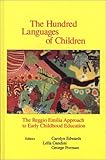The hundred languages of children : the Reggio Emilia approach to early childhood education / [editors] Carolyn Edwards, Lella Gandini, and George Forman.
Material type: TextPublication details: Norwood, N.J. : Ablex Pub. Corp., c1993.Description: xviii, 324 p. : ill. ; 24 cmISBN:
TextPublication details: Norwood, N.J. : Ablex Pub. Corp., c1993.Description: xviii, 324 p. : ill. ; 24 cmISBN: - 9780893919276
- 9780893919337 (pbk.)
- 0893919330
- 372.21 EDW
- LB1139.3.I8 E38 1993
| Item type | Current library | Call number | Copy number | Status | Date due | Barcode | |
|---|---|---|---|---|---|---|---|
| Long Loan | TUS: Midlands, Main Library Athlone General Lending | 372.21 EDW (Browse shelf(Opens below)) | 1 | Available | 00210702 |
Includes bibliographical references (p. 315-317) and indexes.
Part I: Starting points -- 1.Introudction -- 2.What can we learn from Reggio Emilia? -- Part II.Reggio Emilia's educators describe their program: interviews with Lella Gandini -- 3.History, ideas, and basic philosophy -- 4.The community-teacher partnership in the governance of the schools -- 5.The emergent curriculum and social constructivism -- 6.The role of the pedagogista -- 7.The role of the atelierista -- Part III.From the theory to practice -- 8.Educational and caring spaces -- 9.Partner, nurturer, and guide: the roles of the Reggio teacher in action -- 10.Multiple symbolization in the Long Jump project -- 11.Curriculum development in Reggio Emilia: a long-term curriculum project about dinosaurs -- Part IV: The extension of the Reggio Emilia approach into American classrooms -- 12.Cultural variations on developmentally appropriate practice: challenges to theory and practice -- 13.The city in the snow: applying the multisymobolic appraoch in Massachusetts -- 14.Connectons: using the project appraoch with 2- and 3- years olds in a university laboratory school -- 15.Another way of seeing things: we're still learning -- 16.A backward look: from Reggio Emilia to progressive education -- 17.Poppies and the dance of world making -- Conclusion -- 18.Conclusion: where do we go from here?.
